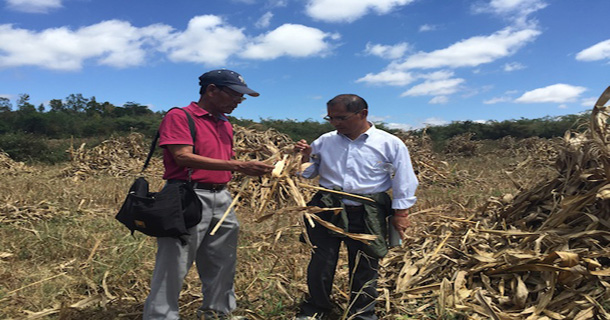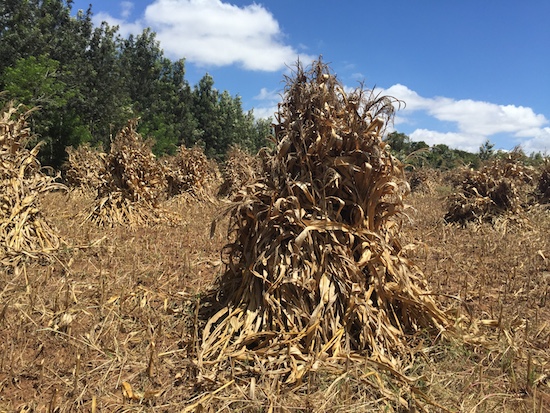
Mr Tsering Dorjee, Joint Secretary, Department of Home, CTA examining a corn field affected by drought
Photo:tibet.net
The Central Tibetan Administration (CTA) has announced a wide ranging compensation scheme to provide relief to hundreds of Tibetan families hit by drought and catastrophic crop failures earlier this year.
Unprecedented droughts caused massive crop failures across India’s five largest Tibetan settlements, which are mostly situated within the Mysore region of the Indian state of Karnataka. The lost crops are valued at over Rs 35 million (US$500,000, £400,000), leaving hundreds of families without food or money for the coming year. Some farmers have been forced to take out extensive loans to cover their debts and living expenses. Surveys have recorded losses of 50-80% of total crop yield in two of the settlements, with some Kollegal residents losing 100% of their expected harvest.
In the announcement on November 11, the CTA pledged to provide compensation to all Tibetan families who lost more than 50% of their crop, with relief expected to be distributed via the CTA’s Disaster Support Fund. Foreign donors are being approached for support, along with overseas Offices of Tibet and Tibetan settlements across India, Nepal and Bhutan.
Mr Chemi Rigzin, Acting Secretary of the Department of Home, offered reassurance to farming communities affected by the droughts saying, “We are faced with the most severe case of crop failure ever recorded in Tibetan exile history. All the five major Tibetan settlements have been gripped by an unfortunate and severe drought this season. However, we have started issuing appeals to our foreign supporters, Offices of Tibet around the world and Tibetan settlements in India, Nepal and Bhutan for immediate relief assistance. We assure all the affected farmers that the department will do its best and all necessary steps would be taken to ensure compensation for the losses”.
The droughts are only the most recent hardship faced by settlers in the region since their arrival from Tibet in 1959.
Official settlement of Tibetans within Karnataka did not begin until 1961, when a tract of uninhabited forest land was leased to the Tibetan community by the Karnataka government, establishing the Lugsung Samdubling settlement. Lugsung Sambdubling provided homes and farmland to around 3,000 Tibetan refugees. These early settlers could not rely on the financial backing of the, then newly formed and underfunded, CTA. A number of temporary settlements were set up and people survived on emergency aid which mostly focused on the provision of food and maintaining child welfare.
The 1966 European Refugee Year led to the provision of over $9,000,000 in aid from the west, and the foundation by the Indian government of the Mysore Resettlement and Development Agency (MYRADA) followed in 1968 which was instrumental in establishing the Tibetan settlements in south India.
The settlers depended on maize production and crafts for their livelihood, the Indian government tapering off financial aid as the settlements gained economic independence. Much like today, reliance on grain production left them exposed to the risk of drought and destitution.
Since then, Tibetan settlers have been engaged in constant struggle with the Indian government, pushing for recognition of their rights as Indian residents. Last year saw a significant victory, with Tibetans being granted rights to lease land and apply for state agricultural aid.
To contribute to the Disaster Support Fund please visit the appeal page at http://tibet.net/2001/11/an-appeal-for-drought-hit-tibetan-refugees/





 Print
Print Email
Email